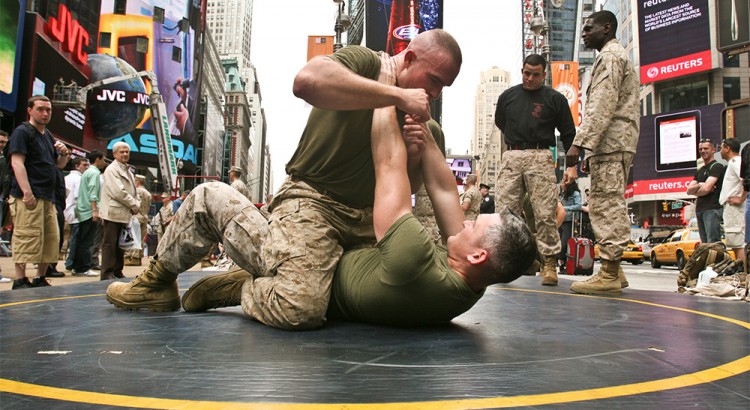Well, yes and no.
Yes, since they all have to learn how to execute some basic Karate kicks and punches and some Brazilian Jiu Jitsu choke-holds and joint-locks properly. And no, since technically they have their own officially prescribed system of martial arts. The U.S. Marine Corps has developed its own unique brand of hand-to-hand and close-quarters combat system using and refining different techniques drawn from different martial arts disciplines, including Boxing, Brazilian Jiu-Jitsu, Savate, Jujutsu, Karate, Judo, Sambo, Krav Maga, Isshin Ryu or Okinawan Karate, Aikido, Muay Thai, Eskrima, Hapkido, Taekwondo, Kung Fu, Kickboxing and bayonet fighting. Simply dubbed the “Marine Corps Martial Arts Program” or MCMAP, it was issued in 2002 and it “replaces all other close-combat related systems preceding its introduction.” Thus, as far as Marines are concerned, they only have one official martial arts style and that is the MCMAP style as taught in their combat curriculum.
MCMAP Slogan and Progression Structure
The MCMAP slogan is “One Mind, Any Weapon.” Under the MCMAP curriculum, Marines are taught how to use the different fighting techniques in varying degrees of lethality depending on different situations. An MCMAP practitioner can use an unarmed restraint to force compliance with minimal damage or he can use debilitating or lethal force when really necessary. The techniques themselves include a wide range of punches, kicks, strikes, grappling, choke holds, joint locks, throws and ground fighting techniques that can be used both defensively and offensively as well as with or without a weapon of opportunity. MCMAP training is conducted in a variety of conditions simulating real life-or-death combat situations.
Like other martial arts, the MCMAP uses a system of colored belts to delineate the different levels of proficiency of the students. The beginner’s belt is colored tan, the second level is represented by a gray belt, the third by a green belt, the fourth by a brown belt, and the fifth by a black belt. A black belter MCMAP practitioner has also varying levels of marks of proficiency- from first degree at the start to sixth degree at the highest end. Since 2007, earning a tan belt, in addition to passing the standard physical and mental exams, has been a requirement for admission to the Marine Corps. A Marine who wants to advance to fourth degree in the MCMAP must also hold at least a first degree black belt in Karate, Muay Thai or any other civilian martial arts program that has been approved by the Corps.
Physical Conditioning
Aside from the training on the proper use of the fighting techniques, the MCMAP has a rigorous physical conditioning regimen that includes drills and exercises that require either or both coordinated teamwork and competition. Marines as part of their martial arts training do calisthenics, running with full gear, log carries, and similar endurance and strengthening exercises on land and in water as well as in low-light or dark conditions to simulate combat stress. They also regularly hold practice bouts and matches to hone their individual fighting skills.
Since fitness is essential to the day-to-day effectiveness and combat readiness of the Marine Corps, Marines are regularly evaluated using the Physical Fitness Test (PFT) and the Body Composition Program (BCP). The PFT is a semi-annual evaluation consisting of three events – pull-ups for male or flexed-arm hang for females, abdominal crunches, and a 3-mile run. The BCP, also conducted on a semi-annual basis, involves comparing a Marine’s weight with the Marine Corps weight allowance chart. For those who meet the standard weight allowance for your height, no further action will be required. For those who did not, they will be measured for body-fat only. If they exceed the body-fat allowance, they will have to reduce until they meet the body fat standards for Marines – which is not to exceed 18-percent for males and not to exceed 26-percent for females.
Mental Discipline and Warrior Ethos
The MCMAP also entails the holding of classroom-type academic discussions regarding fundamental tactics and methods of the past, studies on combative behavior and interpersonal violence, Rules of Engagement and the concept of Force Continuum which deals with when and how much force can be used in response to a given mission. For some who are aiming for higher belt degrees, some courses in formal Professional Military Education (PME) are required, including those which deals with situational awareness, tactical and strategic decision-making, and operational risk management. Character development involves both on-classroom discussion and off-classroom application of the Marine Corps core values, ethics, good citizenship. A Marine should strive to walk the true warrior’s path, much like a samurai’s Bushido or a knight’s Chivalry.
MCMAP and LINE Combatives
The MCMAP evolved from LINE (Linear Infighting Neural Override Engagement) Combatives, a more lethal form of close-quarters fighting system that was used by the Marine Corps from 1989 to 1998. LINE Combatives was replaced after it was found inflexible and lacking in techniques that are appropriate for peacekeeping and other similar missions that did not require use of deadly force.
Also a hybrid of several martial arts like MCMAP, the LINE Combatives techniques are designed to specifically cause death to an opponent. The techniques are also designed to be easily executable by a soldier even in full battle gear under extreme physical and mental fatigue and under poor visibility conditions. The LINE Combatives system is presently still in use among advanced martial arts students, military officers and personnel throughout the special operations, by high-risk law enforcement government agencies and by professional private security service contractors.
